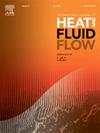Effects of operating conditions on flame evolution and preheating performance of intake manifold burner aided by spray atomization
IF 2.6
3区 工程技术
Q2 ENGINEERING, MECHANICAL
International Journal of Heat and Fluid Flow
Pub Date : 2024-12-27
DOI:10.1016/j.ijheatfluidflow.2024.109730
引用次数: 0
Abstract
The intake manifold burner acts as a cold start auxiliary equipment for heavy diesel engines. The typical intake manifold burner, however, has some drawbacks, including unreliable fuel delivery, insufficient combustion, and poor windproof performance. In this study, a novel intake manifold burner with boosted fuel dispersion was designed, and tests were carried out to investigate the effects of injection pressure, injection frequency, injection duration, and airflow velocity on flame behavior. In addition, the fuel–air mixing process was simulated using a three-dimensional CFD (Computational Fluid Dynamics). To explore the impacts of operating conditions on the gas mixture, the variation tendency of gas/liquid fuel mass was analyzed, and the flame area was quantified. According to the findings, optimization of fuel supply parameters and intake parameters is conducive to flame development and intake air heating. Increasing the amount of fuel injection raises the local and global equivalency ratio, expands the fuel vapor distribution region behind the burner, boosting the flame growth. Airflow velocity and combustion heat release both have an impact on flame evolution. The effects of heat release on flame growth are nearly comparable at low airflow velocity (3–5 m/s), however at high airflow velocity, airflow becomes the dominant factor. High-velocity airflow (greater than 9 m/s) increases heat dissipation, limits flame growth, delays ignition and even blow-out phenomenon. When the air velocity is in the range of 6–7 m/s, the preheating effect is the best.
求助全文
约1分钟内获得全文
求助全文
来源期刊

International Journal of Heat and Fluid Flow
工程技术-工程:机械
CiteScore
5.00
自引率
7.70%
发文量
131
审稿时长
33 days
期刊介绍:
The International Journal of Heat and Fluid Flow welcomes high-quality original contributions on experimental, computational, and physical aspects of convective heat transfer and fluid dynamics relevant to engineering or the environment, including multiphase and microscale flows.
Papers reporting the application of these disciplines to design and development, with emphasis on new technological fields, are also welcomed. Some of these new fields include microscale electronic and mechanical systems; medical and biological systems; and thermal and flow control in both the internal and external environment.
 求助内容:
求助内容: 应助结果提醒方式:
应助结果提醒方式:


